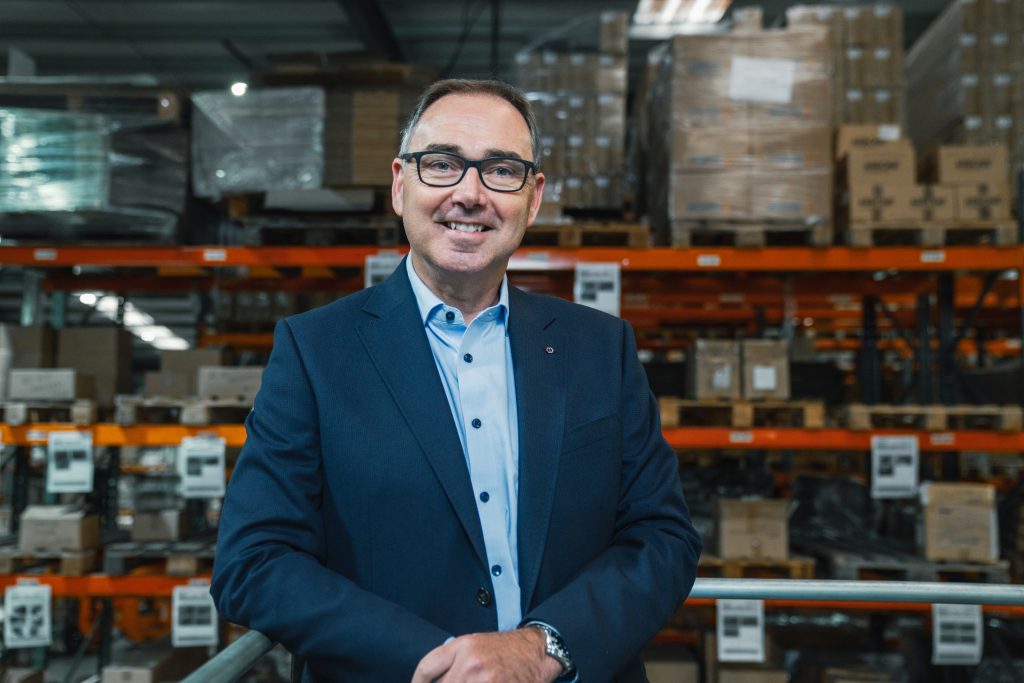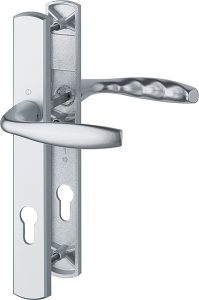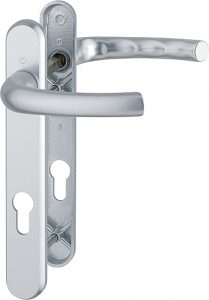For decades, stainless steel has been the go-to material for high-end door and window hardware, particularly in environments demanding strength and durability. Its reputation for toughness and longevity has made it the automatic default for many specifiers and fabricators. But is stainless steel always the best option? Or is it simply the most familiar?
Clearview sat down with Jens Hoppe (Head of Manufacturing Process Innovation), Karl Thomas (Head of Surface Technology HOPPE-Group) and Michael Ottersbach (Head of Innovation Production) in Germany, and Ged Ryan, CEO of HOPPE (UK), to explore the sometimes-overlooked alternative of anodised aluminium; a material that doesn’t just compete with stainless steel but often exceeds it in performance, aesthetics, and versatility.
The Case for Consideration
“We’re not here to say stainless steel is wrong,” Ged Ryan begins. “We manufacture in stainless steel, aluminium, brass, nylon; we’re happy to offer the right material for the right application. But the key is: let’s make that choice informed.”
Too often, Jens explains that, “stainless steel is chosen because people think it’s the strongest, the most durable, that it’ll last forever in any environment. That’s not always the case.”
Karl, from HOPPE’s technical team in Germany, agrees. “Stainless steel can vary massively in quality. It depends on the chromium content. If that’s low, the steel can corrode, even rust. 316 grade performs very well, especially in harsh environments, but cheaper grades like 201 or 304 may not. So, it’s not a one-size-fits-all solution.”
- Jens Hoppe
- Karl Thomas
Anodised Aluminium
Unlike stainless steel, anodised aluminium offers consistency across the board. “Anodising is a stable, controlled process,” explains Karl “You’re not just coating the metal; you’re creating an oxidised layer on the surface that behaves like ceramic. It seals the surface, making it airtight, watertight, and extremely durable.”
It’s a process used across multiple industries, including the automotive sector. “Look at roof rails on cars from the 1990s,” Jens says. “Many were made from anodised aluminium, and they still look good today. That tells you something.”
The Longevity Factor
One of anodised aluminium’s strongest advantages is its long-term performance in real-world environments; especially coastal or urban areas, where humidity, salt, and pollution are major concerns.
“In the UK, we’ve got anodised handles from the 1980s still in the field,” Ged shares. “They look almost as good as the day they were installed. It’s not just about how well a product operates, it’s about how it looks over time. People take confidence from that.”
Stainless steel, despite its name, isn’t always maintenance-free. “It can build up grime, especially in rough finishes. Grease and dirt get into those microscopic valleys,” Karl notes. “Anodised aluminium has a smoother surface, which is much easier to clean and less prone to fingerprint smudges.”
Everyday Durability
Beyond the environment, hardware faces daily wear and tear. Keys, rings, and repetitive use all take their toll. “Anodised aluminium holds up incredibly well,” Ged says. “It’s highly scratch-resistant. And even if it is scratched, the material has a unique ability to self-heal through natural oxidation.”
Karl elaborates: “While the anodised layer is thin, it’s very hard. Minor damage doesn’t spread or degrade like it might in other materials.”
Aesthetic Flexibility
From a design standpoint, anodised aluminium offers a wide array of finishes. “We’ve got sample cases with all sorts of tones: light, dark, grey, brown, metallic,” Ged says. “People often think anodised finishes are just silver or gold, but that’s outdated thinking. You can meet almost any design brief.”
What anodised aluminium lacks in mirror-shine, it makes up for in practicality. “High-gloss finishes tend to show every fingerprint and mark,” adds Michael. “Matte anodised finishes disguise that, while still offering a premium look.”
And because HOPPE does both the manufacturing and anodising in-house, the flexibility is unmatched. “We’re in complete control,” Jens says. “If a fabricator wants a custom colour in volume, we can do that. We’re not waiting three months for a container from overseas.”
The Shape of Things to Come
Beyond appearance, the method of manufacture plays a big role in product design. Stainless steel handles are typically made from tubes, limiting the shapes that can be achieved. Anodised aluminium, being cast, offers more design freedom.
“You can create more ergonomic, curved, or flat profiles with aluminium,” Karl notes. “And that’s important as modern door and window designs become sleeker and more minimal.”
Weight and Commercial Fit
While aluminium is lighter than stainless steel, the difference at the handle level isn’t enormous. Still, in specific applications, like bi-fold or lift-slide doors, every gram counts.
“Stainless handles are hollow tubes, while aluminium ones are solid. So, weight-wise, they’re closer than you’d think,” explains Michael.
Anodised aluminium has proven popular across both commercial and residential sectors. “We supply thousands of handles for apartment blocks, offices, schools, and just as many for residential entrance and patio doors,” Ged adds.
Cost Comparison
Contrary to assumption, anodised aluminium is not a premium-priced option. “The price difference isn’t significant,” Ged says. “It depends more on where the product is made and what grade of stainless is being used. A European-made 304 stainless steel handle will cost more than an anodised aluminium one; and significantly more than a low-grade import.”
The Sustainability Edge
In today’s market, sustainability matters, and it’s here that aluminium has a distinct advantage.
“Aluminium is infinitely recyclable,” Karl explains. “It requires less energy to recycle, and the transportation is cheaper because of its weight. Stainless steel, while recyclable, is more energy-intensive to process.”
HOPPE is committed to environmental responsibility. All of HOPPE’s products are manufactured to ISO environmental standards, and the company is committed to reducing its carbon footprint across the board.
“We track material origins, recyclability, and energy use. We’re moving toward using more recycled aluminium in the first place,” Jens says.
Informed Choices for Better Outcomes
Anodised aluminium offers exceptional corrosion resistance, lower maintenance, aesthetic variety, and sustainability—all with consistent, high-quality performance.
“It’s not about saying one is better than the other in every case,” Jens concludes. “It’s about asking: What’s the right material for this job, this environment, this customer?”
HOPPE’s Handle of Excellence
With more than 30 years in the UK and over 70 years of international expertise, HOPPE’s legacy is one of precision, innovation, and above all: quality. HOPPE’s integrated approach means its customers benefit from the combined knowledge of its technical teams in Germany and its market specialists in the UK, all working together to support you with practical solutions that match performance with style.
Here, HOPPE Germany and HOPPE UK explain that choosing the right material isn’t about defaulting to the familiar; it’s about understanding your environment, your customer’s needs, and your long-term expectations. This discussion isn’t about persuading customers to abandon stainless steel. In some cases, it may well be the right choice. But anodised aluminium deserves a seat at the table, offering durability, aesthetic versatility, corrosion resistance, and sustainable manufacturing, often with lower maintenance and a comparable price tag.
And that’s where HOPPE adds real value – information and education to make sure you get the right product for every specification and application. Working together to make it work better for you.
Ged concludes: “We do everything ourselves, from the product design to the anodising, and that gives us the control to offer real, tangible benefits to customers. Whether it’s aesthetics, sustainability, or long-term durability, we want people to choose the best product for their project. That’s where conversations like this really matter.”







